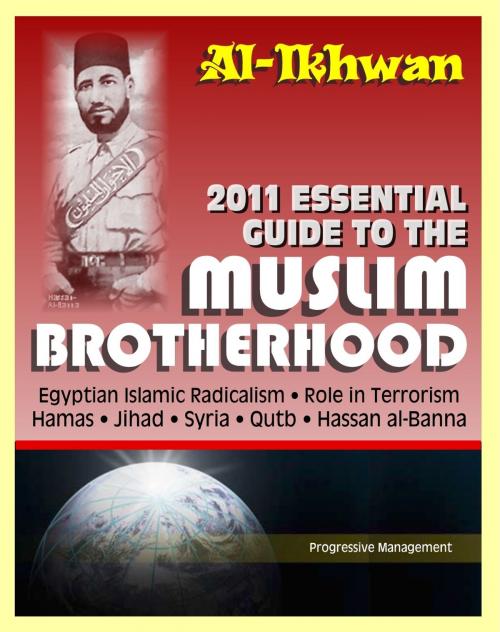2011 Essential Guide to the Muslim Brotherhood (Al-Ikhwan): Authoritative Information and Analysis - From Origins in Egypt to Role in Terrorism, Hamas, Jihad, Egyptian Islamic Radicalism and Uprising, Syria
Nonfiction, Social & Cultural Studies, Political Science| Author: | Progressive Management | ISBN: | 9781458069177 |
| Publisher: | Progressive Management | Publication: | February 1, 2011 |
| Imprint: | Smashwords Edition | Language: | English |
| Author: | Progressive Management |
| ISBN: | 9781458069177 |
| Publisher: | Progressive Management |
| Publication: | February 1, 2011 |
| Imprint: | Smashwords Edition |
| Language: | English |
Discover the history and goals of the Muslim Brotherhood in this essential compilation of expert opinion from over twenty government and military reports and papers, totaling nearly 400 pages. Professional analysis and background data on the MB and related issues includes a detailed history of the organization and its role in Egypt, Syria, and elsewhere in the Middle East, along with links to terrorism and jihad. Islamic experts have stated, "Without closely examining Al-Ikhwan al-Muslimeen (the Muslim Brotherhood) founded in Egypt in 1928, it is impossible to try to understand modern Islamic radicalism. Al-Ikhwan was the first of its kind to politicize Islam within the context of the colonial age and the first to put into practice the theories of Salafist...'God is our purpose, the Prophet our leader, the Qur’an our constitution, Jihad our way and dying for God’s cause our supreme objective' is the slogan of the Muslim Brotherhood, established in 1928 by Hassan Al-Banna. The Muslim Brotherhood or “Al-Ikhwan Al-Muslimum” (in Arabic) represents the “mother movement” of the Islamic fundamentalist. With branches in “70 countries all over the world,” the Muslim Brotherhood is the most pervasive grass roots Islamic fundamentalist movement in the world. The Brotherhood was the first wide-ranging, well-organized, international Islamic movement of modern times...The Muslim Brotherhood requires scrutiny because most of the leaders of the world’s Islamic terrorist groups have their roots in this movement. Ramzi Yousef, the leader of the terrorist cell that attempted to blow up the World Trade Center in 1993, was recruited into the Brotherhood when he attended colleges in Wales. Osama bin Laden was similarly recruited while attending university classes in Saudi Arabia. They, and thousands of others now in terrorist organizations, have embraced the radical Islamist vision articulated by the Brotherhood. If one is to understand the thinking of activists in al Qaeda, Hamas, the Islamic Jihad, and other extreme Islamic groups, the understanding of the Muslim Brotherhood is the place to begin...The extremist ideological leanings that set the precedent for many of today’s radical Islamic movements were articulated by Sayyid Qutb, a member of the Egyptian Muslim Brotherhood, during the 1950s and 1960s. He argued the notion that Islam’s primary enemies are Western cultural liberalism and its Middle Eastern ally — Zionists and Jews generally — and condemned practically all contemporary governments of the Middle East for introducing secular ideologies and developing economic ties to the West that subjugate Islam. The ideas set forth in his book, Signposts on the Road, became the major themes for the ideology of many of today’s violent extremist movements. His stress on the critical importance of militant struggle became a starting point for seminal figures of jihadist thought including Usama Bin Ladin and ‘Ayman al- Zawhari."
Contents include: Al-Ikhwan Al-Muslimeen: The Muslim Brotherhood * The Muslim Brotherhood and Islamic Radicalism * Shaping Jihadism: How Syria Molded the Muslim Brotherhood * Qutbism: An Ideology of Islamic-Fascism * U.S. Military Translation: Muslim Brotherhood document * Egyptian Collection on Islamist Militant Groups * National Commission on Terrorist Attacks Upon the United States Hearing Statement * Hamas: Organizations, Goals and Tactics * 2000 Terrorist Threats To The United States Hearing * West Point Combating Terrorism Center - Harmony and Disharmony: Exploiting Al-Qa'ida's Organizational Vulnerabilities * National Counterterrorism Center Statement: HAMAS (Islamic Resistance Movement) * State Department Office of the Coordinator for Counterterrorism * Strategic Perspectives on the War on Terrorism
Discover the history and goals of the Muslim Brotherhood in this essential compilation of expert opinion from over twenty government and military reports and papers, totaling nearly 400 pages. Professional analysis and background data on the MB and related issues includes a detailed history of the organization and its role in Egypt, Syria, and elsewhere in the Middle East, along with links to terrorism and jihad. Islamic experts have stated, "Without closely examining Al-Ikhwan al-Muslimeen (the Muslim Brotherhood) founded in Egypt in 1928, it is impossible to try to understand modern Islamic radicalism. Al-Ikhwan was the first of its kind to politicize Islam within the context of the colonial age and the first to put into practice the theories of Salafist...'God is our purpose, the Prophet our leader, the Qur’an our constitution, Jihad our way and dying for God’s cause our supreme objective' is the slogan of the Muslim Brotherhood, established in 1928 by Hassan Al-Banna. The Muslim Brotherhood or “Al-Ikhwan Al-Muslimum” (in Arabic) represents the “mother movement” of the Islamic fundamentalist. With branches in “70 countries all over the world,” the Muslim Brotherhood is the most pervasive grass roots Islamic fundamentalist movement in the world. The Brotherhood was the first wide-ranging, well-organized, international Islamic movement of modern times...The Muslim Brotherhood requires scrutiny because most of the leaders of the world’s Islamic terrorist groups have their roots in this movement. Ramzi Yousef, the leader of the terrorist cell that attempted to blow up the World Trade Center in 1993, was recruited into the Brotherhood when he attended colleges in Wales. Osama bin Laden was similarly recruited while attending university classes in Saudi Arabia. They, and thousands of others now in terrorist organizations, have embraced the radical Islamist vision articulated by the Brotherhood. If one is to understand the thinking of activists in al Qaeda, Hamas, the Islamic Jihad, and other extreme Islamic groups, the understanding of the Muslim Brotherhood is the place to begin...The extremist ideological leanings that set the precedent for many of today’s radical Islamic movements were articulated by Sayyid Qutb, a member of the Egyptian Muslim Brotherhood, during the 1950s and 1960s. He argued the notion that Islam’s primary enemies are Western cultural liberalism and its Middle Eastern ally — Zionists and Jews generally — and condemned practically all contemporary governments of the Middle East for introducing secular ideologies and developing economic ties to the West that subjugate Islam. The ideas set forth in his book, Signposts on the Road, became the major themes for the ideology of many of today’s violent extremist movements. His stress on the critical importance of militant struggle became a starting point for seminal figures of jihadist thought including Usama Bin Ladin and ‘Ayman al- Zawhari."
Contents include: Al-Ikhwan Al-Muslimeen: The Muslim Brotherhood * The Muslim Brotherhood and Islamic Radicalism * Shaping Jihadism: How Syria Molded the Muslim Brotherhood * Qutbism: An Ideology of Islamic-Fascism * U.S. Military Translation: Muslim Brotherhood document * Egyptian Collection on Islamist Militant Groups * National Commission on Terrorist Attacks Upon the United States Hearing Statement * Hamas: Organizations, Goals and Tactics * 2000 Terrorist Threats To The United States Hearing * West Point Combating Terrorism Center - Harmony and Disharmony: Exploiting Al-Qa'ida's Organizational Vulnerabilities * National Counterterrorism Center Statement: HAMAS (Islamic Resistance Movement) * State Department Office of the Coordinator for Counterterrorism * Strategic Perspectives on the War on Terrorism















